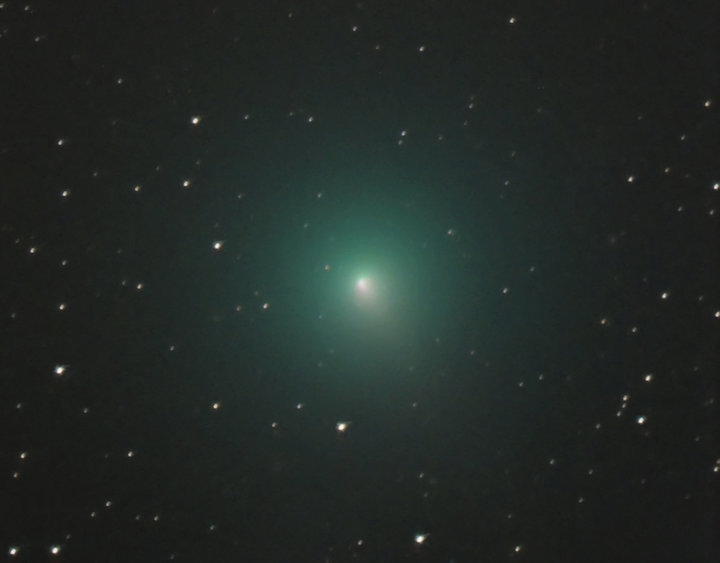4.12.2019
Data from NASA’s Transiting Exoplanet Survey Satellite (TESS) reveal start-to-finish sequence of an outburst from comet 46P/Wirtanen

Comet 46P/Wirtanen from La Palma, ESA
University of Maryland astronomers have made the most complete and detailed observations to date of the formation and dissipation of a naturally occurring comet outburst. Using data from NASA’s Transiting Exoplanet Survey Satellite (TESS), the researchers gained a clear start-to-finish image sequence of an explosive emission of dust, ice and gases during the close approach to Earth of comet 46P/Wirtanen in late 2018. The team members reported their results in the November 22, 2019 issue of The Astrophysical Journal Letters.

“TESS spends nearly a month at a time imaging one portion of the sky. With no day or night breaks and no atmospheric interference, we have a very uniform, long-duration set of observations,” said Tony Farnham, a research scientist in the UMD Department of Astronomy and the lead author of the research paper. “As comets orbit the sun, they can pass through TESS’ field of view. Wirtanen was a high priority for us because of its close approach in late 2018, so we decided to use its appearance in the TESS images as a test case to see what we could get out of it. We did so and were very surprised!”
According to Farnham, the TESS observations of comet Wirtanen were the first to capture all phases of a natural comet outburst, from beginning to end. He noted that three other previous observations came close to recording the beginning of an outburst event. Observations of a 2007 outburst from comet 17P/Holmes began late, missing several hours of the initial brightening phase of the event. In 2017, observations of an outburst from comet 29P/Schwassmann-Wachmann 1 (SW1) concluded early, due to limitations on pre-scheduled observation time. And, while observations from the UMD-led Deep Impact mission captured an outburst from comet Tempel 1 in unprecedented detail in 2005, the outburst was not natural—created instead by the mission’s impactor module. However, the current observations are the first to capture the dissipation phase in its entirety, Farnham said.
Although Wirtanen came closest to Earth on December 16, 2018, the outburst occurred earlier in its approach, beginning on September 26, 2018. The initial brightening of the outburst occurred in two distinct phases, with an hour-long flash followed by a more gradual second stage that continued to grow brighter for another 8 hours. This second stage was likely caused by the gradual spreading of comet dust from the outburst, which causes the dust cloud to reflect more sunlight overall. After reaching peak brightness, the comet faded gradually over a period of more than two weeks. Because TESS takes detailed, composite images every 30 minutes, the team was able to view each phase in exquisite detail.
“With 20 days’ worth of very frequent images, we were able to assess changes in brightness very easily. That’s what TESS was designed for, to perform its primary job as an exoplanet surveyor,” Farnham said. “We can’t predict when comet outbursts will happen. But even if we somehow had the opportunity to schedule these observations, we couldn’t have done any better in terms of timing. The outburst happened mere days after the observations started.”
Farnham and his colleagues are also the first to observe Wirtanen’s dust trail. Unlike a comet’s tail—the spray of gas and fine dust that follows behind a comet, growing as it approaches the sun—a comet’s trail is a field of larger debris that traces the comet’s orbital path as it travels around the sun. Unlike a tail, which changes direction as it is blown by the solar wind, the orientation of the trail stays more or less constant over time.
“The trail more closely follows the orbit of the comet, while the tail is more offset from it, as it gets pushed around by the sun’s radiation pressure. What’s significant about the trail is that it contains the largest material,” said Michael Kelley, an associate research scientist in the UMD Department of Astronomy and a co-author of the research paper. “Tail dust is very fine, a lot like smoke. But trail dust is much larger—more like sand and pebbles. We think comets lose most of their mass through their dust trails. When the Earth runs into a comet’s dust trail, we get meteor showers.”
While the current study describes initial results, Farnham, Kelley and their colleagues look forward to further analyses of Wirtanen, as well as other comets in TESS’ field of view. The team has generated a rough estimate of how much material may have been ejected in the outburst (about 2.2 million pounds, which could have left a crater close to 65 feet across), but further analysis of the estimated particle sizes in the dust tail may help improve this estimate. Observing more comets will also help to determine whether multi-stage brightening is rare or commonplace in comet outbursts.
“We also don’t know what causes natural outbursts and that’s ultimately what we want to find,” Farnham said. “There are at least four other comets in the same area of the sky where TESS made these observations, with a total of about 50 comets expected in the first two years’ worth of TESS data. There’s a lot that can come of these data. We’re still finding out the capabilities of TESS, so hopefully we’ll have more to report on this comet and others very soon.”
Quelle: UNIVERSITY OF MARYLAND
